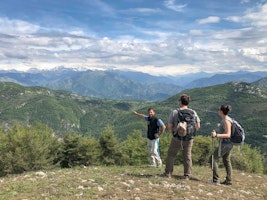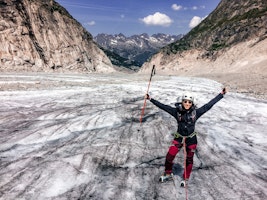Touring the eclectic and isolated beauty of Corsica is a life-changing experience. From the deep-rooted history of its culture-rich cities to the plentiful peaks of ancient granite, this island paradise has established a particularly alluring reputation for worldwide travelers with a flair for adventure. The French territory is the most mountainous island in the Mediterranean Sea, located off the southwestern coast of mainland France and west of the Italian Peninsula, with Sardinia sitting directly to its south.
There are a plethora of scenic hiking trails in Corsica, with trekkers and hikers from all across the globe flocking to its remote island wilderness. Programs for families and beginners who want to enjoy its culture and beauty are just as plentiful as the demanding routes for dedicated backpackers and seasoned veterans intent on defeating the most arduous and compelling topography in the Mediterranean.
It is an especially intriguing destination for its GR20 hiking trail. Among other fabulous routes crawling across the island, none can compare to Europe’s alleged most difficult hiking trail. Not only does it cover the entire island, it moves from shore to captivating shore through the unusual terrain that is unique to Corsica.

Whether you are taking in the Mediterranean meadow-lands on the southern leg of the journey, maneuvering through the Aiguilles de Bavella and their thrilling granite spires, or admiring the surreal Lac de Nino and its pozzines, the GR20 is sure to leave a lasting impression of Corsica.
Location
The GR20 runs diagonally from the northwest to the southeast, splitting Corsica down the middle. The starting and finishing cities are relatively close to the coast, and the hike covers the varied landscape of the island every step of the way.
Calvi is a coastal city with ample accommodations within 13 kilometers of Calenzana, making it a natural point of entry for GR20 hikers and those scouring the north for great treks. In the southeast, Porto Vecchio is near the GR20 hub of Conca, and is a great place to start for eastern and southern hikes.

Larger cities, like the capital Ajaccio in the west, Bonifacio at the southern tip of the island, and Bastia in the northeast, are fantastic jumping off points for other memorable hikes, as well. They have unparalleled access to the coasts, and boat trips can make any excursion a more enjoyable affair. Anyone with a taste for rock climbing in Corsica can benefit from these spots.
Where to stay before the trek
Corsica boasts a large number of touristic cities and accommodation options for all budgets. We asked local guide Julie Michel and she recommended several places to stay across the country:
Haute-Corse
On a budget:
- Si Mea (Corte)
- Hotel Monte d'Oro (Vizzavona)
- Auberge De La Foret Bonifatu (Calenzana)
- Casa di Lucia (Mazzola)
- Casa di Floumy (Calvi)
Top-notch:
- La Signoria (Calvi)
- La Dimora – Les Collectionneurs (Cap Corse, Oletta)
- Hôtel Demeure Castel Brando (Erbalunga)
- Dominique Colonna (Corte)
- Hotel Liberata (L'Île-Rousse)
Corse-du-Sud
On a budget
- Auberge A Pignata (Levie)
- Sole E Monti (Quenza)
- Hotel Clair de Lune (Zonza)
- Le Neptune & Spa (Propiano)
- Hotel Bella Vista (Porto)
- Chambres d'Hôtes Villa Cardellini (Aullène)
- Casa Sarrinca (Serra-di-Scopamene)
Top-notch
- Grand Hôtel de Cala Rossa (Lecci)
- Hotel Version Maquis Citadelle (Bonifacio)
- Hôtel-Demeure Les Mouettes (Ajaccio)
- Hotel Capo Rosso (Piana)
Trek Distance
The trail is about 180 kilometers in total from Calenzana to Conca (or vice versa, depending on your starting point). While this can seem a daunting distance to undertake for any level of trekker, the GR20 can be broken down into smaller hikes, most notably the northern section from Calenzana to Vizzavona and the southern section from Vizzavona to Conca. There is no advantage to starting in the north or the south.
Because of its steep paths and rugged footfalls, the northern section is considered the more difficult portion of the trail. The stunning landscape in the north tends to be superior to that of its southern counterpart. This section features Cirque de la Solitude, a steep portion of chained climbing, and the serene Lac de Nino amidst quaint mountain meadows. If you have time to divert from the trail, Monte Cinto is a reasonable side trip that is certainly worth the effort.

Not to be outdone, the southern part contains the amazing meadows of the Coscione Plateau with Monte Incudine (2,134m) towering over it. The less demanding trail also allows hikers and trekkers uncompromising opportunities to take in this fascinating island, with the evocative cliffs of Bavella awaiting you near the end of the trail.
Duration
For most adventurers taking part in this hike, it lasts about 15 days. This all depends on the weather, the strength and ability of the trekkers, and the personal objectives of the individuals. With the right mindset and preparation, a devoted backpacker could hustle through the course in five days. Most participants, however, take the time to appreciate the immaculate terrain, the exciting challenges, and the once-in-a-lifetime experience of conquering the most difficult hike in Europe.
Since the route is quite a sustained undertaking, it can be broken down into different segments. It is common to hike only part of the trail to make it a more personalized and manageable experience. There are tons of great GR20 hiking trips that include, some, part, or all of the route.

Accommodation
It is generally accepted that trekkers will stay at mountain refuges throughout the trek, with an option to camp near the huts should vacancy be limited. It is always a good idea to plan ahead and reserve your place at the huts. They can sleep anywhere from 25 hikers to 50, supplementing a stay with food and possibly supplies. Trekkers can expect to pay around €10 a night for a refuge and €5 a night to camp. Camping is available only in designated places near the huts and is not permitted along the trail itself.
Each day is considered a “stage,” so the route contains 15 stages. There are other options with regards to mountain huts and refuges, but the following is a guide when planning your way across the GR20:
- Calenzana – Refuge d’Ortu di u Piobbu
- Refuge d’Ortu di u Piobbu – Refuge de Carrozzu
- Refuge de Carrozzu – Refuge d’Asco Stagnu
- Refuge d’Asco Stagnu – Refuge Tighjettu
- Refuge Tighjettu – Refuge de Ciottulu di i Mori
- Refuge de Ciottulu di i Mori – Refuge de Manganu
- Refuge de Mananu – Refuge de Pietra Piana
- Refuge de Pietra Piana – Refuge de l’Onda
- Refuge de l’Onda – Vizzavona
- Vizzavona – Bergeries de Capannelle
- Bergeries de Capannelle – Refuge de Prati
- Refuge de Prati – Refuge d’Usciolu
- Refuge d’Usciolu – Refuge d’Asinao
- Refuge d’Asinao – Refuge de Paliri
- Refuge de Paliri – Conca

Getting there
The two most popular ways to get to the island are by air and sea. Flying into one of the two larger hubs, Ajaccio or Bastia, are common and easier to plan. For any travelers who are taking their time while heading to the trail, this is a reasonable option and even allows for trekkers to explore different areas and hikes on the island.
Hikers who wish to start the trail in Calenzana can fly into the Sainte Catherine Airport in the northwest corner of the island. It is roughly 13 kilometers from the trailhead, and about seven kilometers to the coastal city of Calvi. There is no public transportation service from the airport, so hang on to a few Euros to pay for a taxi.
For southern trekkers, flying into the Figari South Corsica Airport – about a 44-kilometer drive from Conca – is also possible. There are phenomenal destinations in the area, like Bonifacio in the south or Porto-Vecchio on the way, that have incredible views of the Tyrrhenian Sea and the Mediterranean.

There is ferry service to Calvi in the north and Porto Vecchio in the south. Passengers can enjoy a delightful boat ride from mainland European countries that most definitely enhances the aesthetic pleasures of the trip.
Physical Condition / Difficulty
The beauty of the GR20 lies within its exciting challenges. The gorgeous Corsican countryside abounds with heart-pumping trails that should be taken seriously. Previous experience hiking and trekking – and even mountaineering – is an invaluable asset. Participants will be trekking roughly six or seven hours a day, including elevation changes over difficult terrain.
For the most part, the route itself is clearly marked, but being comfortable with route finding and navigating is beneficial along the GR20. Some of the northern areas have more technical portions that occasionally come equipped with ladders and chains for assistance.

Having the mental fortitude to complete the trek is often one of the most difficult obstacles for participants along the trail. It is important to prepare for the mental duration of the route to complement the physical requirements to safely complete the GR20.
Weather
The best time to hike the on the GR20 and in Corsica is within the summer months, taking advantage of the comfortable Mediterranean climate. The conditions from June all the way through October are the most favorable for the sustained trek, though the throngs may hit the trail during July and August. If you wanted to avoid the crowds, consider early- or late-season hikes – the temperatures are milder during June, September, and October.
The temperature is generally pleasant, with average temperatures (in Celsius) in the 20s. While hikers can expect sunny and dry days, the weather can be unpredictable. Storms are common and tend to be more frequent at higher altitudes. It is reasonable to add an extra day or two to a trip for inclement weather.

Other Hiking Routes in Corsica
While the GR20 dominates the central landscape of the island, Corsica has impeccably enchanting hikes of all shapes and sizes. The western coast of the island is full of wonderful routes, including Mare e Monti.
Traversing this region is a great way for intermediate trekkers to stay busy with captivating challenges and unforgiving beauty, scouting places like the Gulf of Porto – a UNESCO World Heritage Site – and the Scandola Reserve. Check out this timeless trip that covers all of this and even includes a bit of the GR20. Keep an eye out for the Calanques de Piana, the iconic red cliffs in the Gulf of Porto.
Cap Corse at the northeastern tip of the island is a remarkable region to hike. From Bastia to the Agriates Desert to the high ridges with views of the Alps, there are several hikes in this island corner abound. Some journeys even feature a jaunt to the vineyard for an exclusive tasting of tasty regional wines.

Destinations that you just can’t miss include Restonica Valley with its unforgettable mountain lakes and Bonifacio, at the southern tip of the island, with its extraordinary citadel. The beaches also have the varied landscape the island is known for, so surprising adventures are always within reach.
Hiking adventures can even combine canyoning trips to add an extra level of excitement to your program!
What are you waiting for? Book a trek now and explore the never-ending beauty of an iconic island!

Traverse an entire island by grabbing a guide and hiking the illustrious GR20! Or check out one of the many other hiking trails on the incomparable island of Corsica and discover the magic in the middle of the Mediterranean!







